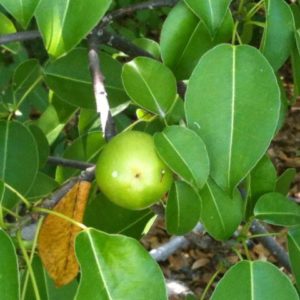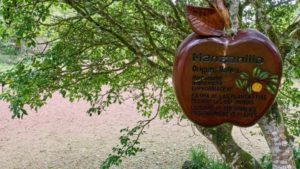Maybe the first image that comes to mind when we think of poison apples is Disney’s Witch Evil Queen, from the 1937 film “Snow White and the Seven Dwarfs”. Or maybe it has to do with the story of British mathematician Alan Turing, who died in 1954 after biting into an apple laced with cyanide. It is not likely that we think of a real-life death apple. As it happens, it does exist. Have you ever heard of the manchineel tree?
The manchineel is a +20 feet tall tree that grows on sandy beaches throughout the coasts of the Americas, from South Florida all the way down to Colombia and Venezuela. Due to the superficial resemblance of its fruits and leaves to those of a real apple tree, it is commonly known as manzanillo de playa, (little beach apple), manzanilla de la muerte (little apple of death), or leaving no room for doubt, “el arbol de la muerte” (the tree of death). Its scientific name is Hippomanane Mancinella and it is so toxic that it is included in The Guinness Book of Records as “the most dangerous tree in the world”.
Its fruits are sweet and look a lot like small apples. They are the most toxic part of the tree. If ingested, they cause severe vomiting, high fever, diarrhea, inflammation and ulceration of the pharynx, hemorrhage of the upper digestive tract, bradycardia (slow heart rate), coma and death. The tree also produces a highly caustic, milky and white sap, that can cause serious dermatitis, blisters, and burn-like lesions.
Facts and Lore

– Supposedly it was Christopher Columbus who named it ‘manzanita de la muerte’ after some of his sailors ate them and got poisoned.
– When the Spaniards arrived and tried to conquer their territories, the local Caribe Indians used the resin from the tree to poison the conquistadores’ water supplies and to coat the tips of their blow-darts and arrows.
– Don Juan Ponce de León y Figueroa was a Spanish Conquistador. He is widely credited with the discovery and naming of Florida in 1513. He is also remembered for his search of the mythical fountain of youth. In 1521, while looking for the fabled fountain, Ponce de León and his men were attacked by the natives. Many of his men died and Ponce de León himself got an arrow in his shoulder. This wound would end up causing his death. Legend has it that the arrow was poisoned with sap from the árbol de la muerte.
– In Martinique and Trinidad, most manchineel trees have been identified with a red stripe, an x or other warning sign on the trunk.
– After drying it in the sun to neutralize its poisonous sap, the wood from the manchineel is used to make furniture. It can not be used for firewood though, as the resulting smoke can irritate the skin, mucous membranes, and conjunctivae.
– It is not a good tree to sit under during a rainstorm, as the droplets of water falling off the leaves and branches can carry off the toxic resin and cause severe skin and mucose irritation. For the same reason, it is not a good idea to touch the leaves, the bark or any part of the tree.
– While every part of the tree is dangerous for humans and mammals in general, reptiles like iguanas are not affected by irá toxins and can eat the fruit.
– Some authors indicate that the manchineel has some medicinal properties. In homeopathy and folk medicine it is used to treat the fear of getting insane. In Jamaica, it has been used to treat venereal diseases and dropsy.
– Phorbol, a natural, plant-derived organic compound present in the tree’s resin is used as a biomedical research tool to study carcinogenesis.
– In Florida, the manzanillo of death is an endangered species.
What To Do

The manchineel is more often found on Costa Rica’s Pacific coast. In many places, like National Park Manuel Antonio the trees are marked and there are signs that warn about their toxicity. Even so, many visitors ignore them and eat the fruit because they are hungry, curious or careless. This year several people, both adults, and children have been affected.
– Use common sense. NEVER eat the unknown leaves or fruits of any wild plants.
– In case you come into contact with the tree sap, wash the area with plenty of water and soap. In any case, seek medical attention immediately. The treatment is basically supportive care.


